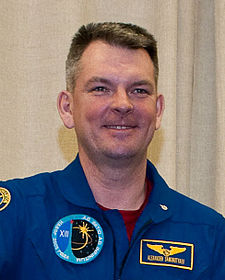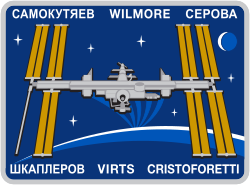Alexandr Samokuťajev
| Alexandr Michajlovič Samokuťajev | |
|---|---|
 | |
| Kosmonaut CPK | |
| Státní příslušnost | Rusko |
| Datum narození | 13. března 1970 (52 let) |
| Místo narození | Penza, Penzenská oblast, RSFSR, SSSR |
| Předchozí zaměstnání | Vojenský pilot |
| Hodnost | Plukovník (od 2012 v záloze) |
| Čas ve vesmíru | 331 dní, 11 hodin a 23 minut |
| Kosmonaut od | 29. května 2003 |
| Mise | Expedice 27/28 (Sojuz TMA-21/ISS) Expedice 41/42 (Sojuz TMA-14M/ISS) |
| Znaky misí | |
| Kosmonaut do | 22. května 2017 |
| Pozdější zaměstnání | Kosmonaut-manažer ve Středisku přípravy kosmonautů |
| Některá data mohou pocházet z datové položky. | |
Alexandr Michajlovič Samokuťajev (rusky Александр Михайлович Самокутяев, * 13. března 1970 v Penze, RSFSR, SSSR) byl původně pilot ruského vojenského letectva, v letech 2003–2017 byl ruským kosmonautem, členem oddílu kosmonautů CPK. Od roku 2008 se připravoval na svůj první kosmický let na Mezinárodní vesmírnou stanici (ISS) jako člen Expedice 27/28, do vesmíru vzlétl začátkem dubna 2011 a přistál v polovině září 2011. Podruhé do vesmíru vzlétl jako člen Expedice 41/42 v září 2014, opět na půl roku.
Život
Mládí
Alexandr Samokuťajev pochází z povolžské Penzy, po střední škole byl přijat ke studiu na místním polytechnickém institutu, ale už následující rok přestoupil na Černigovskou vojenskou vysokou leteckou školu (Черниговское Высшее военное авиационное училище летчиков), absolvoval ji roku 1992.[1]
Po studiu zůstal v Černigově jako instruktor, později byl přeložen ve stejné funkci na vrtulníkovou školu na Ukrajině, poté sloužil na Dálném východě. V letech 1998–2000 studoval na Gagarinově vojenské letecké akademii, načež byl jmenován náčelníkem organizačně-plánovacího oddělení 2. správy Střediska přípravy kosmonautů (CPK).[1]
Kosmonaut
Přihlásil se k výběru kosmonautů a 29. května 2003 získal doporučení Státní meziresortní komise k zařazení do oddílu kosmonautů CPK. Absolvoval dvouletou všeobecnou kosmickou přípravu a 5. července 2005 získal kvalifikaci zkušební kosmonaut.[1]
Byl zařazen mezi kosmonauty připravující se na lety na Mezinárodní vesmírnou stanici (ISS). V červenci 2008 byl včleněn do záložní posádky Expedice 25 (start v září 2010).[1] V říjnu 2008 byl vybrán do hlavní posádky Expedice 27, jejíž start v Sojuzu TMA-21 je plánován na březen 2011.[1] Jmenování oficiálně potvrdila NASA v říjnu 2009.[2]

K prvnímu letu odstartoval v lodi Sojuz TMA-21 z kosmodromu Bajkonur 4. dubna 2011 v 22:18 UTC ve funkci velitele lodi společně s palubními inženýry Andrejem Borisenkem a Ronaldem Garanem. Po dvoudenním letu se 6. dubna Sojuz spojil s Mezinárodní vesmírnou stanicí.[3] Na ISS pracoval ve funkci palubního inženýra Expedic 27 28, jednou vystoupil do vesmíru. Po 164 dnech letu přistál s kolegy Borisenkem a Garanem v Sojuzu TMA-21 v Kazachstánu, 150 km jihovýchodně od Džezkazganu.[4]
V létě (květen–červenec) byl uvolněn z armády. Po odchodu Dmitrije Kondraťjeva z oddílu kosmonautů ho nahradil (v září 2012) v Expedici 41/42 s očekávaným startem v září 2014 v Sojuzu TMA-14M s Jelenou Serovovou a Barry Wilmorem.[1] Ke svému druhému letu odstartoval 25. září 2014 na palubě Sojuzu TMA-14M ve funkci velitele lodi. Po necelých šesti hodinách letu se Sojuz spojil se stanicí ISS a kosmonauti se zapojili do práce Expedice 41.[5] Na ISS Samokuťajev opět zastával funkci palubního inženýra a opět vystoupil na povrch stanice. Dne 12. března 2015 se se Serovovou a Wilmorem vrátil na Zem.[1]
Roku 2015 se stal zástupcem velitele oddílu kosmonautů, k 22. květnu 2017 ztratil status aktivního kosmonauta, přitom však zůstal zástupcem velitele oddílu jako takzvaný „kosmonaut-manažer“.[1][6]
Alexandr Samokuťajev je ženatý, má jednu dceru.[1]
Vyznamenání
- Hrdina Ruské federace (25. června 2012),[1]
- Letec-kosmonaut Ruské federace (25. června 2012),[1]
- Řád Za zásluhy o vlast IV. třídy (15. února 2016).[1]
Odkazy
Reference
- ↑ a b c d e f g h i j k l IVANOV, Ivan, a kol. Космическая энциклопедия ASTROnote [online]. Moskva: rev. 2012-10-3 [cit. 2012-10-11]. Kapitola Александр Михайлович Самокутяев. Dostupné online. (rusky)
- ↑ YEMBRICK, John. Release: 09-233. NASA and its International Partners Assign Space Station Crews [online]. Washington: NASA, 2009-10-07 [cit. 2009-10-15]. Dostupné online. (anglicky)
- ↑ HOLUB, Aleš. MEK. Malá encyklopedie kosmonautiky [online]. Praha: rev. 2011-04-07 [cit. 2011-06-23]. Kapitola Sojuz TMA-21. [Dále jen Holub]. Dostupné online.
- ↑ VÍTEK, Antonín. SPACE 40. Velká encyklopedie družic a kosmických sond [online]. Praha: rev. 2011-09-16 [cit. 2011-09-16]. Kapitola 2011-012A - Sojuz-TMA 21. Dostupné online.
- ↑ Holub. Rev. 2014-9-26 [cit. 2014-09-29]. Kapitola Sojuz TMA-12M.
- ↑ РЫЖКОВ, Евгений; МАРИНИН, Игорь. О космонавтах и астронавтах. Русский космос. Červen 2019, s. 18–25. Dostupné online. (rusky)
Externí odkazy
 Obrázky, zvuky či videa k tématu Alexandr Samokuťajev na Wikimedia Commons
Obrázky, zvuky či videa k tématu Alexandr Samokuťajev na Wikimedia Commons - SAMOKUŤAJEV, Alexandr. Почтовый ящик космонавтов МКС [online]. Moskva: Roskosmos [cit. 2012-10-11]. Blog a fotografie Samokuťajeva v „poštovní schránce“ kosmonautů z ISS. Dostupné v archivu pořízeném dne 2012-10-19. (rusky)
Média použitá na této stránce
The Expedition 41 crew members have released their patch and have written some text to go along with it:
- "Portraying the road of human exploration into our vastly unknown universe, all elements of the Expedition 41 patch build from the foundation, our Earth, to the stars beyond our solar system. The focus of our six-month expedition to the International Space Station (ISS) is Earth and its inhabitants as well as a scientific look out into our universe. The distinguishing ISS solar arrays reach onward and serve as the central element, with the icon of an atom underneath representing the multitude of research onboard that will bring new discoveries for the benefit of humanity. The sun is rising over Earth's horizon, spreading its light along the road of human exploration. Equipped with the knowledge and inspiration gained from ISS, our successful multinational cooperation will lead human space exploration to the moon, Mars, and ultimately, the stars. We are Expedition 41. Join us for the adventure."
Expedition 42 Cosmonaut Elena Serova of the Russian Federal Space Agency (Roscosmos, left, Alexander Samokutyaev of Roscosmos, center, and NASA Astronaut Barry Wilmore of NASA sit in chairs outside the Soyuz TMA-14M spacecraft just minutes after they landed in a remote area near the town of Zhezkazgan, Kazakhstan on Thursday, March 12, 2015. NASA Astronaut Wilmore, Russian Cosmonauts Samokutyaev and Serova are returning after almost six months onboard the International Space Station where they served as members of the Expedition 41 and 42 crews.
Russian cosmonaut Alexander Samokutyayev
The rectangular-shaped design portrays the International Space Station orbiting planet Earth with its solar array wings spread wide. Facing the sun with the lower left outboard solar array feathered, the left array portrays a prominent number "4" and the fully deployed arrays on the right form the Roman numeral version of "2," which signifies the two increment crews which, together, comprise the six-member international Expedition "42" crew. The crew and all supporting personnel around the world are also represented by the six stars adorning the sky around the complex.
The Expedition 27 patch depicts the International Space Station (ISS) prominently orbiting Earth, continuing its mission for science, technology and education. The ISS is an ever-present reminder of the cooperation between the United States, Russia, Japan, Canada, and the European Space Agency (ESA) – and of the scientific, technical, and cultural achievements that have resulted from that unique teamwork. The ISS is shown in its completed status with the latest addition of the Alpha Magnetic Spectrometer (AMS), and with two resupply vehicles docked at each end of the station. The Southern Cross Constellation is also show in the foreground and its five stars, along with the sun, symbolize the six international crew members that live and work on the space station. The Southern Cross is one of the smallest modern constellations, and also one of the most distinctive. It has cultural significance all over the world and inspires teams to push the boundaries of their worlds, both in space and on the ground.
In the foreground of the Expedition 28 patch, the International Space Station is prominently displayed to acknowledge the efforts of the entire International Space Station (ISS) team – both the crews who have assembled and operated it, and the team of scientists, engineers, and support personnel on Earth who have provided a foundation for each successful mission. Their efforts and accomplishments have demonstrated the Space Station's capabilities as a technology test bed and a science laboratory, as well as a path to the human exploration of our solar system and beyond. This Expedition 28 patch represents the teamwork among the international partners – USA, Russia, Japan, Canada, and the ESA – and the ongoing commitment from each partner to build, improve, and utilize the ISS. Prominently displayed in the background is our home planet, Earth – the focus of much of our exploration and research on our outpost in space. Also prominently displayed in the background is the Moon. The Moon is included in the design to stress the importance of our planet's closest neighbor to the future of our world. Expedition 28 is scheduled to occur during the timeframe of the 50th anniversary of both the first human in space, Russian cosmonaut Yuri Gagarin and the first American in space, astronaut, Alan Shepard. To acknowledge the significant milestone of 50 years of human spaceflight, the names "Гагарин" and "Shepard" as well as "50 Years" are included in the patch design.





